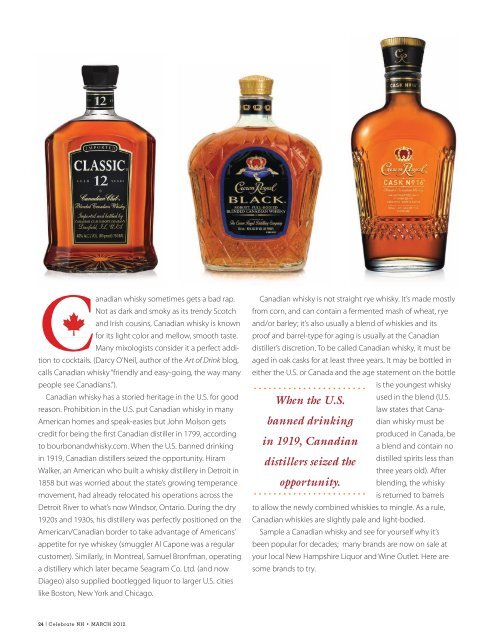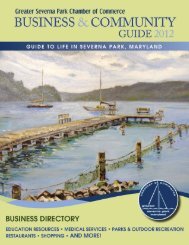Canadian Whisky - BlueToad
Canadian Whisky - BlueToad
Canadian Whisky - BlueToad
Create successful ePaper yourself
Turn your PDF publications into a flip-book with our unique Google optimized e-Paper software.
<strong>Canadian</strong> whisky sometimes gets a bad rap.<br />
Not as dark and smoky as its trendy Scotch<br />
and Irish cousins, <strong>Canadian</strong> whisky is known<br />
for its light color and mellow, smooth taste.<br />
Many mixologists consider it a perfect addition<br />
to cocktails. (Darcy O’Neil, author of the Art of Drink blog,<br />
calls <strong>Canadian</strong> whisky “friendly and easy-going, the way many<br />
people see <strong>Canadian</strong>s.”).<br />
<strong>Canadian</strong> whisky has a storied heritage in the U.S. for good<br />
reason. Prohibition in the U.S. put <strong>Canadian</strong> whisky in many<br />
American homes and speak-easies but John Molson gets<br />
credit for being the first <strong>Canadian</strong> distiller in 1799, according<br />
to bourbonandwhisky.com. When the U.S. banned drinking<br />
in 1919, <strong>Canadian</strong> distillers seized the opportunity. Hiram<br />
Walker, an American who built a whisky distillery in Detroit in<br />
1858 but was worried about the state’s growing temperance<br />
movement, had already relocated his operations across the<br />
Detroit River to what’s now Windsor, Ontario. During the dry<br />
1920s and 1930s, his distillery was perfectly positioned on the<br />
American/<strong>Canadian</strong> border to take advantage of Americans’<br />
appetite for rye whiskey (smuggler Al Capone was a regular<br />
customer). Similarly, in Montreal, Samuel Bronfman, operating<br />
a distillery which later became Seagram Co. Ltd. (and now<br />
Diageo) also supplied bootlegged liquor to larger U.S. cities<br />
like Boston, New York and Chicago.<br />
<strong>Canadian</strong> whisky is not straight rye whisky. It’s made mostly<br />
from corn, and can contain a fermented mash of wheat, rye<br />
and/or barley; it’s also usually a blend of whiskies and its<br />
proof and barrel-type for aging is usually at the <strong>Canadian</strong><br />
distiller’s discretion. To be called <strong>Canadian</strong> whisky, it must be<br />
aged in oak casks for at least three years. It may be bottled in<br />
either the U.S. or Canada and the age statement on the bottle<br />
is the youngest whisky<br />
When the U.S.<br />
banned drinking<br />
in 1919, <strong>Canadian</strong><br />
distillers seized the<br />
opportunity.<br />
used in the blend (U.S.<br />
law states that <strong>Canadian</strong><br />
whisky must be<br />
produced in Canada, be<br />
a blend and contain no<br />
distilled spirits less than<br />
three years old). After<br />
blending, the whisky<br />
is returned to barrels<br />
to allow the newly combined whiskies to mingle. As a rule,<br />
<strong>Canadian</strong> whiskies are slightly pale and light-bodied.<br />
Sample a <strong>Canadian</strong> whisky and see for yourself why it’s<br />
been popular for decades; many brands are now on sale at<br />
your local New Hampshire Liquor and Wine Outlet. Here are<br />
some brands to try.<br />
24 | celebrate NH • march 2o12






